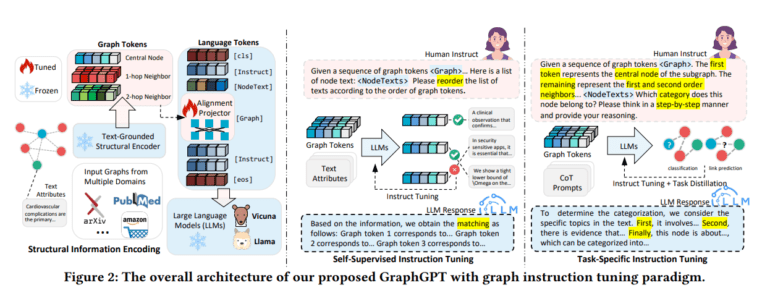TL;DR:
- Researchers introduce GraphGPT to enhance generalization in graph models.
- GraphGPT addresses limitations in incorporating structural knowledge into language models.
- The framework employs a dual-stage graph instruction tuning paradigm and alignment projector.
- Extensive evaluations demonstrate its efficacy in supervised and zero-shot graph learning.
- GraphGPT outperforms existing methods and offers adaptability for diverse tasks.
- Future directions include exploring pruning techniques for improved model efficiency.
Main AI News:
In the recent publication titled “GraphGPT: Elevating Graph Models with Cutting-Edge Language Model Techniques,” a group of researchers has embarked on a mission to address a pivotal concern within the realm of natural language processing, specifically within the domain of graph models. Their objective? To bolster the generalization capabilities of graph models is a pivotal prerequisite for their widespread utility.
Before the inception of their groundbreaking innovation, GraphGPT, an array of methods and frameworks existed for working with graphs. However, these approaches frequently grappled with the challenge of effectively integrating domain-specific structural knowledge into language models (LLMs). As a result, these models were hindered in their capacity to comprehend and decipher the intricate structural components of graphs, ultimately undermining their overall performance.
Enter the GraphGPT framework, a pioneering solution to these limitations. This framework leverages a dual-stage graph instruction tuning paradigm in tandem with a graph-text alignment projector to infuse domain-specific structural knowledge into LLMs. This synergy of techniques significantly augments the LLMs’ capacity to grasp the structural facets of graphs, marking an extraordinary stride forward in graph modeling.
The GraphGPT framework, as proposed, presents a trove of promising outcomes, as corroborated by extensive assessments across diverse scenarios. These evaluations span both supervised and zero-shot graph learning contexts. In both realms, the framework unmistakably demonstrates its efficacy in enhancing graph-related tasks and learning. This adaptability is paramount, as it empowers the model to navigate an array of downstream datasets and tasks without succumbing to the pitfall of catastrophic forgetting, a challenge that has plagued other models.
The results derived from these comprehensive evaluations underscore the profound potential of GraphGPT in amplifying the generalization prowess of LLMs in graph-centric tasks. It surpasses existing methodologies across varied settings, positioning it as an invaluable asset to the field.
The debut of GraphGPT heralds a groundbreaking stride in the domain of graph modeling. It confronts the longstanding predicament of enhancing the generalization capabilities of graph models, offering an influential avenue to incorporate domain-specific structural knowledge into LLMs. The comprehensive evaluations unequivocally establish the effectiveness of this framework, both in supervised and zero-shot graph learning scenarios, emphasizing its versatility for a wide array of applications.
Regarding future trajectories, the researchers advocate for the exploration of pruning techniques aimed at reducing the overall model size while preserving its performance. This endeavor holds the potential to further enhance the pragmaticity and efficiency of the GraphGPT framework. Altogether, this work signifies a substantial leap forward within the sphere of graph modeling and stands poised to exert a momentous influence on diverse applications reliant on graph data.
Conclusion:
The introduction of GraphGPT represents a significant breakthrough in graph modeling, offering advanced capabilities in generalization and domain-specific structural knowledge integration. This innovation is poised to have a transformative impact on the market, empowering businesses and industries to leverage graph data more effectively for a wide range of applications, ultimately driving innovation and efficiency in various sectors.

